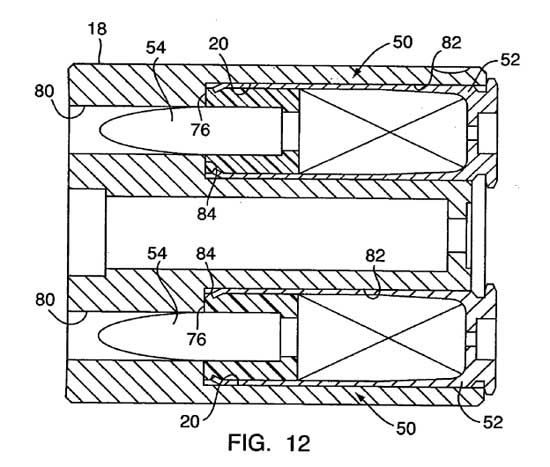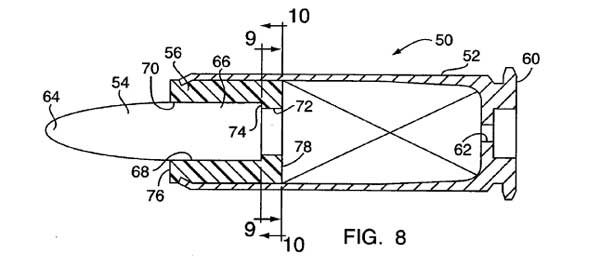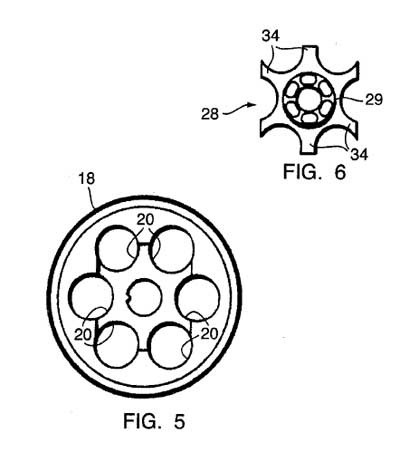In 2005, Smith & Wesson filed a patent application for a “high velocity ammunition system and firearm.” Â The abstract stated the bullets fired from this handgun would achieve muzzle velocities in excess of 25,000 fps!
Let’s put 25,000 fps into context…
- 25,000 fps is more than 17,000 miles per hour.
- This is more than 22 times the speed of sound.
- The .221 Fireball shot from a single shot pistol is the fastest SAAMI-spec handgun cartridge at about 2700 fps.
- Federal’s 220 Swift load only manages 4250 fps at the muzzle from a rifle.
When I started reading the patent application, I expected that the 25,000 fps was a typo. Â It just seemed so far outside the realm of possibility to achieve those speeds from any conventional firearm, much less a handgun.
Well, several pages into the application, I find a second reference to “high velocity.” Â This time the term is used to describe speeds in excess of 2,500 fps. Â This velocity definitely seems much more reasonable. Â I’d have to say the first figure listed was a typo.
However, the application is interesting for reasons other than typos.
It seems that S&W was attempting to patent a sabot-type ammunition and matching revolver. Â Smith & Wesson cited the inability to develop a revolver design that would reliably shoot and extract bottleneck cased ammunition. Â This limited the guns to using straight wall cased ammo.

In an effort to overcome this limitation, S&W came up with the idea of using a disintegrating sabot to achieve similar results to a bottleneck cartridge.
The patent application described a smaller than normal projectile that was partially encased in a sabot. Â The sabot was then seated in a straight wall case like used in a .357 Magnum or .44 Magnum cartridge. Â When fired, the sabot would move the projectile forward. Â The projectile would then engage the rifling and be propelled forward.
The sabot would be made of plastic that would then disintegrate and be expelled out of the bore.
Interestingly, the diagrams included with the patent application showed a square extractor. Â S&W obtained a patent for a square revolver extractor in 1993.
I could not find where a patent was actually issued. Â However, I am intrigued by the idea. Â I wonder what kind of velocity one could get with a .22 projectile from a .45 Colt case? Â Probably not 25,000 fps.


20 replies on “25,000 FPS Handgun Cartridge”
My first thought was that the bullet would self-destruct at that speed, and then I thought that the gun would never be strong enough to contain the pressure necessary for that velocity.
25,000 fps from a handgun. I would quote the townspeople from the movie, Blazing Saddles.
25,000 fps is simply impossible with a single charge gun & cartridge. The theoretical maximum is about 5,400 fps before choked flow makes it simply impossible to push any more gas down a soda straw. The 120 mm smooth bore Rheinmetall cannon fires an APFSDS (Armor Piercing, Fin Stabilized, Discarding Sabot) round at 5,200 fps. The 220 Swift, on the other hand, has reached more sedentary velocities of 4,400 fps with lightweight bullets.
Sabot rounds are a fascinating study. Readers will remember the Remington Accelerator rounds. The .308 Accelerator would fire a 22 caliber bullet at speeds over 4,000 fps. Accuracy was less than stellar, awful might be a better term, and hoplophobes of the day had panic attacks at the prospect of recovering bullets with no rifling marks;.conveniently ignoring the fact the rifling marks were on the Nylon sabot near the point where the round was fired. Accelerators would shoot about a 6 inch group in my HK-91and would not cycle the action.
I have not experimented extensively with sabot loads in pistol cartridges but it is quite easy to load your own sabot rounds using Speer shot capsules in a 357 Magnum case. The inside diameter of the shot capsule is .307/.308; a 30 caliber bullet fits quite nicely. Using this method, it is quite possible to fire a variety of 30 caliber bullets from a 38 caliber revolver including 32 caliber pistol bullets which are .308 diameter. Obviously, there is no loading data for such a load. Be extremely careful should you decide to experiment with this.
Thanks! I love to play with sabots, so I’ll have to (carefully) try that sometime. The last time I used those capsules was to assemble some of the old “3-1” buckshot loads.
In theory, I suppose one could insert a .22-cal bullet in a .30 cal sabot, then place the whole thing in a shot capsule & fire it out of a revolver. Silly? Absolutely. But could be fun.
Of course, at .357 handgun velocities, the bullet might not separate consistently from the sabot, or if it did, tumble. Hmm. This might be more intruiging than I thought.
This looks like a variation on Charles R. (Bob) Olsen’s “Invicta” cartridges. He saw it as the basis for achieving higher velocities in a revolver without the need to use a heavily bottlenecked cartridge case with its setback problems. The trick was that the barrel was only bored large enough for the projectile. The larger sabot/sleeve stopped against the rear of the barrel, sealing the gap between the cylinder and the barrel, adding to the possible velocity achievable.
The models he showed to the shooting press back in the early/mid-80s were built on Dan Wesson revolvers. I suspect that no one wanted to market it due to the possibility that some idiot would slip a standard cartridge into the cylinder and try to shoot it out of the smaller diameter bore.
Olsen’s US Patents can be seen online:
http://www.google.com/patents?id=Pi0uAAAAEBAJ&printsec=abstract&zoom=4&dq=4393782#PPA9,M1
http://www.google.com/patents?id=l9EsAAAAEBAJ&printsec=abstract&zoom=4&dq=4457093#PPA2,M1
The closest thing I’ve seen or heard about to that kind of speed is a developmental round for the military. Saw it on the History or Military Channel. But it’s completely non-traditional. No powders or casings. Instead, the round is a very stream-lined dart that is hurled down range via electro-magnetic propulsion.
Pretty devastating results.